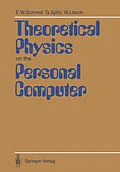We would like to thank Mr. A.H. Armstrong, who translated this book, for his many valuable suggestions and corrections. We also acknowledge a stimulating response from our readers. Mr. J. Peeck sent us a diskette containing the pro grams modified to run on an ATARI computer. Mr. H.U. Zimmermann sent us diskettes, on which the graphics software of the book is adapted to the require ments of the FORTRAN-77 compiler by MICROSOFT. Readers interested in these adaptations should contact the authors. Tiibingen, January 1988 E. W. Schmid, G. Spitz v Preface to the German Edition This book is based on the lecture course "Computer applications in Theo retical Physics", which has been offered at the University of Tiibingen since 1979. This course had as its original aim the preparation of students for a nu merical diploma course in theoretical physics. It soon became clear, however, that the course provides a valuable supplement to the fundamental lectures in theoretical physics. Whereas teaching in this field had previously been prin cipally characterised by the derivation of equations, it is now possible to give deeper understanding by means of application examples. A graphical presen tation of numerical results proves to be important in emphasizing the physics. Interaction with the machine is also valuable. At the end of each calculation the computer should ask the question: "Repeat the calculation with new data (yes/no)?". The student can then answer "yes" and input the new data, e.g.
Inhalt
1. Introduction.- 1.1 Programming of the Numerical Portions of the Programs.- 1.2 Programming of the Input and Output.- 2. Numerical Differentiation and Introduction into Screen Dialogue.- 2.1 Formulation of the Problem.- 2.2 Mathematical Methods.- 2.3 Programming.- 2.4 Exercises.- 2.5 Solutions to the Exercises.- 3. Numerical Integration.- 3.1 Formulation of the Problem.- 3.2 Numerical Methods.- 3.2.1 The Trapezoidal Rule.- 3.2.2 The Simpson Rule.- 3.2.3 Newton-Cotes Integration.- 3.2.4 The Gauss-Legendre Integration.- 3.3 Programming.- 3.4 Exercises.- 3.5 Solutions to the Exercises.- 4. Harmonic Oscillations with Sliding and Static Friction, Graphical Output of Curves.- 4.1 Formulation of the Problem.- 4.2 Numerical Treatment.- 4.2.1 Transformation of the Differential Equation.- 4.2.2 The Euler Method.- 4.3 Programming.- 4.4 Exercises.- 4.5 Solutions to the Exercises.- 5. Anharmonic Free and Forced Oscillations.- 5.1 Formulation of the Problem.- 5.2 Numerical Treatment.- 5.2.1 Improvement of the Euler Method.- 5.2.2 The Runge-Kutta Method.- 5.3 Programming.- 5.4 Exercises.- 5.5 Solutions to the Exercises.- 6. Coupled Harmonic Oscillations.- 6.1 Formulation of the Problem.- 6.2 Numerical Method.- 6.3 Programming.- 6.4 Exercises.- 6.5 Solutions to the Exercises.- 7. The Flight Path of a Space Craft as a Solution of the Hamilton Equations.- 7.1 Formulation of the Problem.- 7.2 Mathematical Methods.- 7.2.1 Mesh Width Adaptation in the Runge-Kutta Method.- 7.2.2 Coordinate Transformation.- 7.3 Programming.- 7.3.1 Hamilton's Equations of Motion.- 7.3.2 Automatic Mesh Width Adjustment in the Runge-Kutta Method.- 7.3.3 Coordinate Transformation.- 7.3.4 Main Program.- 7.4 Exercises.- 7.5 Solutions to the Exercises.- 8. The Celestial Mechanics Three-body Problem.- 8.1 Formulation of the Problem.- 8.2 Mathematical Method.- 8.3 Programming.- 8.4 Exercises.- 8.5 Solutions to the Exercises.- 9. Computation of Electric Fields by the Method of Successive Over-relaxation.- 9.1 Formulation of the Problem.- 9.2 Numerical Method.- 9.2.1 Discretisation of Laplace's Equation.- 9.2.2 The Method of Successive Over-relaxation.- 9.3 Programming.- 9.4 Exercises.- 9.5 Solutions to the Exercises.- 10. The Van der Waals Equation.- 10.1 Formulation of the Problem.- 10.2 Numerical Method.- 10.3 Programming.- 10.4 Exercises.- 10.5 Solutions to the Exercises.- 11. Solution of the Fourier Heat Conduction Equation and the "Geo-Power Station".- 11.1 Formulation of the Problem.- 11.2 Method of Solution.- 11.3 Programming.- 11.4 Exercises.- 11.5 Solutions to the Exercises.- 12. Group and Phase Velocity in the Example of Water Waves.- 12.1 Formulation of the Problem.- 12.2 Numerical Method.- 12.3 Programming.- 12.4 Exercises.- 12.5 Solutions to the Exercises.- 13. Solution of the Radial Schrödinger Equation by the Fox-Goodwin Method.- 13.1 Formulation of the Problem.- 13.2 Numerical Method of Solution.- 13.3 Programming.- 13.4 Exercises.- 13.5 Solutions to the Exercises.- 14. The Quantum Mechanical Harmonic Oscillator.- 14.1 Formulation of the Problem.- 14.2 Numerical Method.- 14.3 Programming.- 14.4 Exercises.- 14.5 Solutions to the Exercises.- 15. Solution of the Schrödinger Equation in Harmonic Oscillator Representation.- 15.1 Formulation of the Problem.- 15.2 Numerical Method.- 15.3 Programming.- 15.4 Exercises.- 15.5 Solutions to the Exercises.- 16. The Ground State of the Helium Atom by the Hylleraas Method.- 16.1 Formulation of the Problem.- 16.2 Setting up the State Basis and the Matrix Equation.- 16.3 Programming.- 16.4 Exercises.- 16.5 Solutions to the Exercises.- 17. The Spherical Harmonics.- 17.1 Formulation of the Problem.- 17.2 Numerical Method.- 17.3 Programming.- 17.4 Exercises.- 17.5 Solutions to the Exercises.- 18. The Spherical Bessel Functions.- 18.1 Formulation of the Problem.- 18.2 Mathematical Method.- 18.3 Programming.- 18.4 Exercises.- 18.5 Solutions to the Exercises.- 19. Scattering of an Uncharged Particle from a Spherically Symmetric Potential.- 19.1 Formulation of the Problem.- 19.2 Mathematical Treatment of the Scattering Problem.- 19.3 Programming.- 19.4 Exercises.- 19.5 Solutions to the Exercises.- References.
